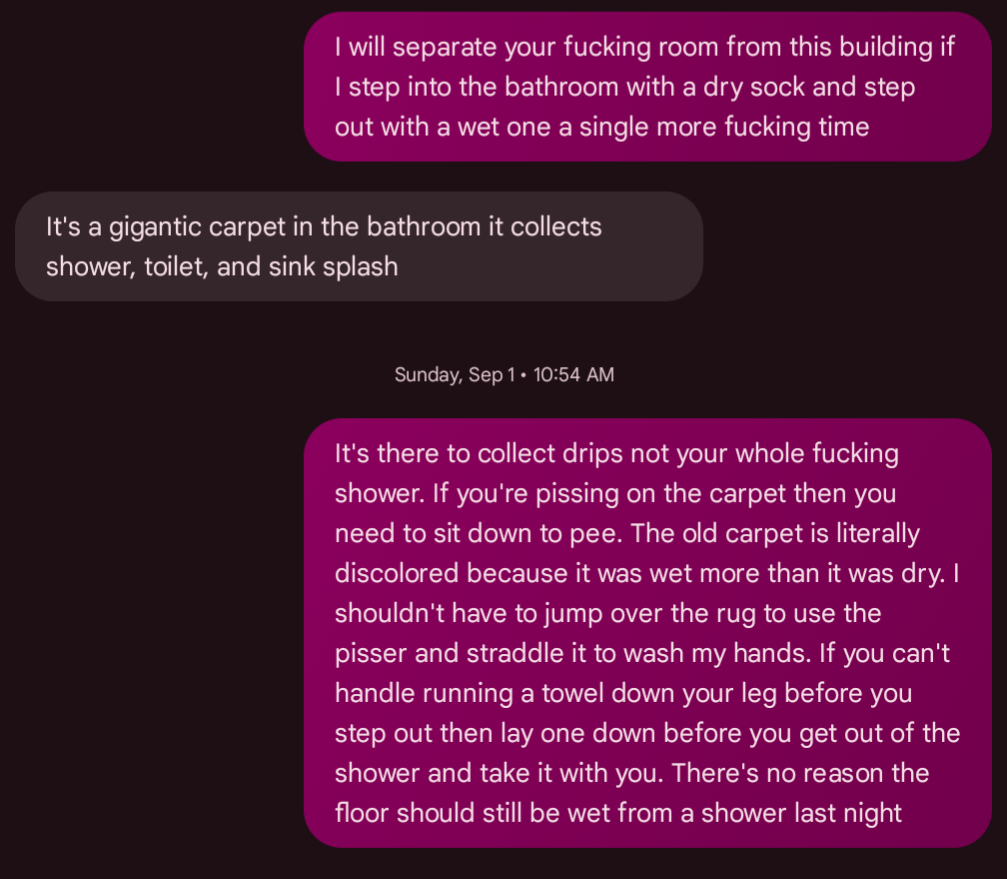







I’m so glad you said this; my roommate didn’t do this. The (single) bathroom mat would be absolutely soaked when he’d get out of the shower, and would remain that way for hours after. Everytime I mentioned it he’d say “that’s what a bathmat is for” and I eventually had someone else mention how they had their socks soaked before I finally got him to start drying himself off first



Some of these are yearly but reduced to monthly for ease of viewing


Arcane is a fantastic series, eagerly awaiting the next season. Even my sister is into it (and as far as I know she has no clue what League of Legends is)


Another point for Linux


Interesting, both of my F40 installs with btrfs only have a root folder, but it looks like yours has created separate ones for /, /home, and /boot. run ll /mnt/boot; ll /mnt/home; ll /mnt/root so I can take a quick look at where things are located. My best guess is that sda1 gets mounted to /mnt/boot, while everything else (/dev, /sys, etc) gets mounted to /mnt/root


Since you’re using btrfs, there is likely another subfolder under /mnt. ll /mnt will tell you this, but the drive isn’t still mounted from the other day. When you’re mounting the EFI partition, you’re going to want to mount it to that folder, and not /mnt itself (/mnt/root/boot/efi, instead of /mnt/boot/efi) same for the binds (/dev, /proc, /run, etc)


Could you send me the output of lsblk -no FSTYPE /dev/sda3 and ll /mnt?


Apologies, I think I got a bit ahead of myself in the description.
Once you’ve determined which partition is which (in your case, /dev/sda1 does appear to be the EFI partition, and /dev/sda3 appears to be your root partition), you need to mount them in this order
mount /dev/sda3 /mnt
mount /dev/sda1 /mnt/boot/efi


That’s alright, I’ll do my best to walk you through it.
Your drive contains multiple partitions (/dev/sda1 through /dev/sda3).
One of these drives is going to be your EFI partition. This is what your system can read before linux boots, your BIOS can’t understand ext4 / btrfs / etc, but it can understand fat32.
If you run lsblk -no FSTYPE /dev/sda1 it should return vfat if that’s your EFI partition. That’s what we’re going to mount to /mnt/boot/efi
I’m assuming that /dev/sda3 is your data partition, e.g. where your linux install is. You can find the filesystem format the same way as your EFI partition.
Edit: After determining which partition is which, you’re going to want to mount the root partition, and then the EFI partition
mount /dev/sda3 /mnt
mount /dev/sda1 /mnt/boot/efi
Unix systems have theology of “everything is a file”, all devices and system interfaces are mounted as files. As such, to be able to properly chroot into an offline install, we need to make binds from our running system to the offline system. That’s what’s achieved by running for i in /dev /dev/pts /proc /sys /run; do sudo mount -B $i /mnt$i; done
This is just a simple loop that mounts /dev, /dev/pts, /proc, /sys, and /run to your offline install. You’re going to want to either add /sys/firmware/efi/efivars to that list, or mount it (with -B, which is shorthand for --bind, not a normal mount).
Once you’ve done this, you should be able to successfully chroot into /mnt (or /mnt/root if running btrfs)
At this point, you should be able to run your grub repair commands.


I’m doing my morning scroll before I start my day, so I can’t delve too deep, but this is the article I always reference when I have to do repairs
https://askubuntu.com/a/831241
#1 thing I noticed in your image is that lsblk only shows you partitions, and doesn’t mount them. You probably want /dev/sda3 mounted at /mnt
The only thing from the article you want to modify is using
mount -B /sys/firmware/efi/efivars /mnt/sys/efi/efivars, I believe the functionality changed since that article was written and that’s what worked for me
Additionally, if you drive is formatted as btrfs instead of ext4, once you mount your drive your root will most likely be at /mnt/admin or similar. Mount subdirectories to that folder instead of /mnt
If you have questions lmk and I’ll get back to you at some point today
SFC has worked numerous times for me, usually for botched updates. Haven’t used it in a long time after leaving tech support


I ripped one on a pew during a Christmas eve service once